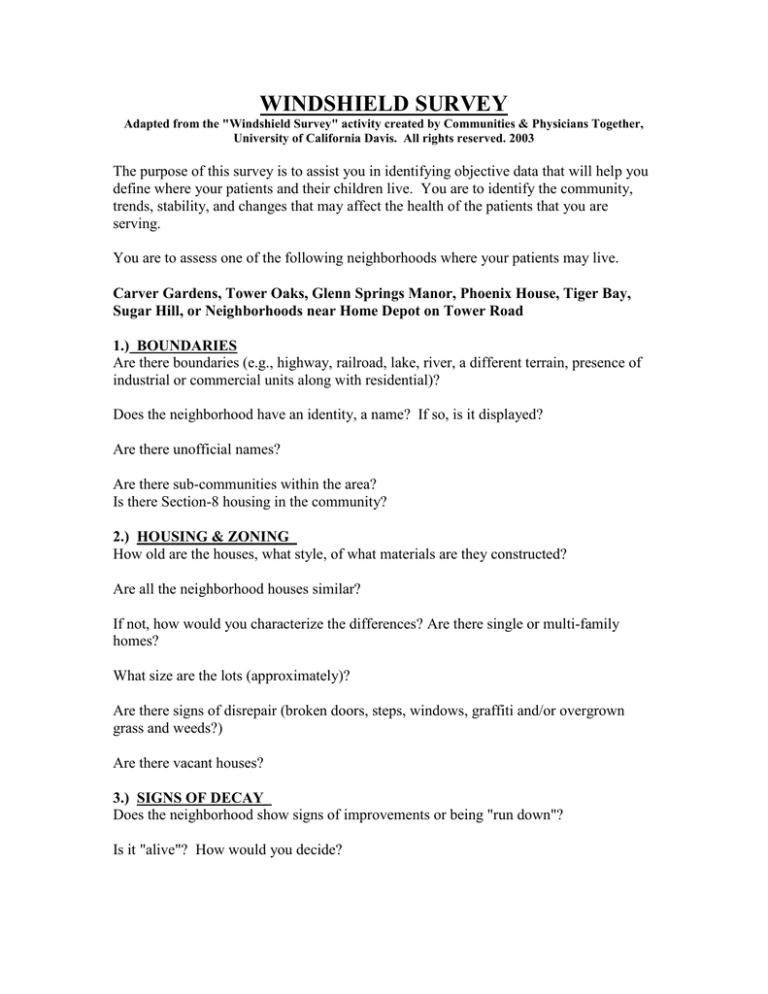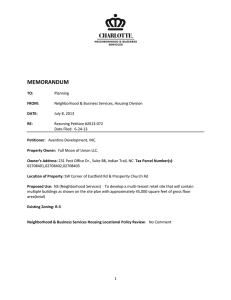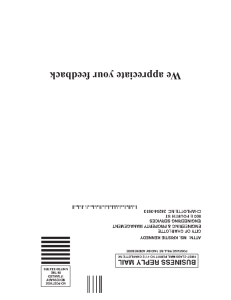
WINDSHIELD SURVEY
Adapted from the "Windshield Survey" activity created by Communities & Physicians Together,
University of California Davis. All rights reserved. 2003
The purpose of this survey is to assist you in identifying objective data that will help you
define where your patients and their children live. You are to identify the community,
trends, stability, and changes that may affect the health of the patients that you are
serving.
You are to assess one of the following neighborhoods where your patients may live.
Carver Gardens, Tower Oaks, Glenn Springs Manor, Phoenix House, Tiger Bay,
Sugar Hill, or Neighborhoods near Home Depot on Tower Road
1.) BOUNDARIES
Are there boundaries (e.g., highway, railroad, lake, river, a different terrain, presence of
industrial or commercial units along with residential)?
Does the neighborhood have an identity, a name? If so, is it displayed?
Are there unofficial names?
Are there sub-communities within the area?
Is there Section-8 housing in the community?
2.) HOUSING & ZONING
How old are the houses, what style, of what materials are they constructed?
Are all the neighborhood houses similar?
If not, how would you characterize the differences? Are there single or multi-family
homes?
What size are the lots (approximately)?
Are there signs of disrepair (broken doors, steps, windows, graffiti and/or overgrown
grass and weeds?)
Are there vacant houses?
3.) SIGNS OF DECAY
Does the neighborhood show signs of improvements or being "run down"?
Is it "alive"? How would you decide?
Is there trash, abandoned cars, boarded up buildings, rubble, dilapidated buildings,
rubble-filled vacant lots, poor drainage, and potential disease vector areas?
4.) PARKS & RECREATIONAL AREAS
Are there parks & recreational areas in the neighborhood?
Is the open space public or private?
Who uses it?
5.) "COMMONS"
What are the neighborhood hangouts?
For what groups, at what hours? (e.g., school year, candy store, bar, restaurant, park,
community buildings, and gas station?). Who is hanging out at these places?
Does the "Commons" have a sense of territoriality or is it open to strangers?
6.)STORES
What supermarkets or neighborhood stores are available? Where is the nearest food
store? Does it carry fresh produce and fresh or frozen meat and fish?
If you had to walk to a food store, what could you buy to eat? What could you purchase
for a toddler to eat?
How do residents travel to the store?
Are there drug stores, laundries, dry cleaners?
Where is the closest pharmacy?
Where is the closest laundry mat?
7.) TRANSPORTATION
How do people get in and out of the neighborhood?
What is the condition of the streets? Are there sidewalks?
Are there street lights? Do they work at night? Is there a major highway near the
neighborhood?
Whom does it serve?
Is public transportation available? Where are the bus stops? How many bus stops are
there?
If you had to take a bus to Shands, how long would it take you?
8.) SERVICE CENTERS
Are there social agencies, recreation centers, schools, or daycares?
Are there health care providers-physicians, dentists, clinics, emergency rooms, hospitals?
9.) PEOPLE ON THE STREET
Who is on the streets? (e.g., women, children, teenagers, community health nurses,
collection agents, salesmen, DCF caseworkers)?
How are they dressed?
What animals do you see (e.g., strays, pets, other)?
10.) PROTECTIVE SERVICES
Is there evidence of police & fire protection in the area?
11.) RACE
Are there various racial groups in the neighborhood?
How many are there?
12.) ETHNICITY/RELIGION
What churches & church schools are in the neighborhood?
How many are there?
13.) SOCIO-ECONOMIC STATUS
How would you categorize the residents: upper, lower, upper middle, middle, working,
etc.? On what do you base this judgment?
14.) HEALTH & SAFETY
Is there evidence of accidents, substance abuse, poor lighting on streets, poor
sidewalk/street condition? On what do you base this judgment?
Are cyclists wearing helmets?
Are sidewalks clear of obstacles?
Would you feel safe in this neighborhood after dark?
If you had children living in this neighborhood, then what one thing would be your most
significant concern?
What crimes are reported in this neighborhood? What products do you see advertised?
How many registered sex offenders live within the neighborhood?
YOUR SUMMARY OF THE OVERALL ASSESSMENT OF THE
NEIGHBORHOOD


